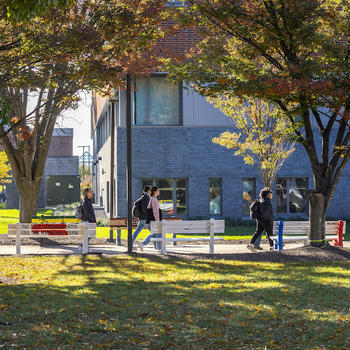A recent State Council of Higher Education for Virginia-conducted analysis of Virginia’s public four-year institutions shows George Mason University topping or leading most peers in a variety of metrics, including growth, opportunity, value, efficiency, return on investment, and state economic impact.

The findings in a “fact pack” were compiled by Boston Consulting Group and the State Council of Higher Education for Virginia (SCHEV). Mason President Gregory Washington reviewed the data with the Board of Visitors at the governing body’s Feb. 22 meeting in Merten Hall. The fact packs for all of the state’s public four-year institutions can be found here.
“George Mason is the greatest human development initiative in this state since Reconstruction, and I think the data bears that out,” Washington said. “It is not just special. It is actually unprecedented. We are the shining light on the hill that others should be looking at to say, ‘How do we replicate that?’”
Among the Mason highlights:
- Enrollment growth: 2.2% from 2013 to 2022 as Mason solidified its standing as the largest and most diverse public university in the state.
- Opportunity/retention/completion: An acceptance rate of 91%, a first-year retention rate of 87%, and a six-year graduation rate of 69%.
- Affordability: Cost of attendance, what students pay after financial aid, scholarships and other assistance, increased by 0.4% ($400) between 2018-19 and 2021-22 for in-state undergraduates.
- Serving financially challenged students: 32% with Pell recipient status in 2021-22, which is 5% more than the median of Virginia four-year public universities.
- Efficiency: Mason ranks at or near the bottom in administrative cost per student and administrative/instructional cost ratio among the state’s four-year public institutions.
- State economic impact: 73% of in-state Mason graduates stay in Virginia—3% higher than public four-year institutions in the state—and earn among the highest-paying salaries. For out-of-state Mason students, 29% remain in Virginia after graduation, 9% higher than the state average.
“There is no better investment of taxpayer dollars from an ROI perspective relative to George Mason, and I can make that claim based on these results,” Washington said. “If you were going to paint a picture of what you want an academic institution to be for this state and nation, you would get an institution that looks like this one.”
Video of the Feb. 22 meeting can be accessed here and meeting materials here.
Other highlights from the meeting:
- The Office of Safety, Emergency, and Enterprise Risk Management (SEERM) is now Risk, Safety, and Resilience and will be led by Chief Risk Officer Julie Zobel, former associate vice president for SEERM. Zobel is leading the university’s updated Enterprise Risk Assessment and will report directly to the president. Look for a future story with details in an upcoming issue of The George email newsletter.
- The Governor’s Office has approved the incentive retirement plan that Mason had submitted.
- Deb Dickenson, executive vice president for finance and administration, and Rose Pascarell, vice president for University Life, will host a town hall March 21 to engage students about a proposed tuition increase, which would be capped at 3% for in-state undergraduate students.
- Keith Renshaw, senior associate provost for undergraduate education, provided an overview of the history, process, and course review status for the Mason Core including the new Just Societies course requirement scheduled to begin fall 2024 for new students. Mason Core courses are designed to “meet the needs of employers, students themselves, our state and region and society at large” and to fulfill accreditation requirements, Renshaw said. Following the BOV meeting, Mason Rector Horace Blackman created a university committee in response to questions raised by BOV members about the process of developing the new Mason Core requirements to continue the conversation and report back with recommendations at the next BOV meeting in May.
- Research expenditures are up 31.2% in FY24, said Andre Marshall, vice president for research, innovation, and economic impact.
